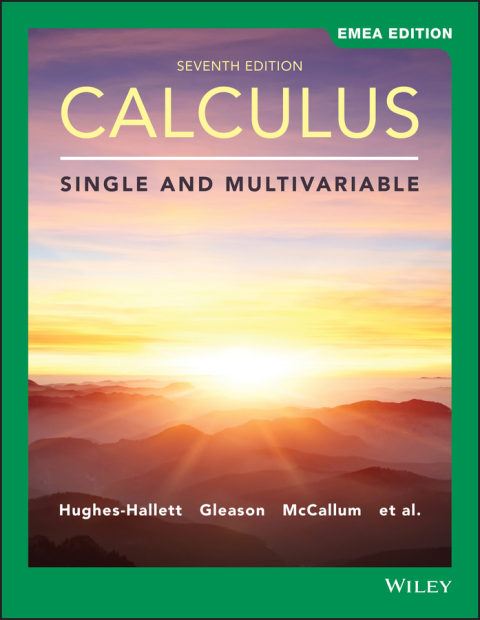Description
Efnisyfirlit
- Cover Page
- Title Page
- Dedication
- Copyright
- Preface
- Acknowledgments
- Chapter 1: Foundation for Calculus: Functions and Limits
- 1.1 Functions and change
- 1.2 Exponential functions
- 1.3 New functions from old
- 1.4 Logarithmic functions
- 1.5 Trigonometric functions
- 1.6 Powers, Polynomials, and Rational functions
- 1.7 Introduction to limits and continuity
- 1.8 Extending the idea of a limit
- 1.9 Further limit calculations using Algebra
- 1.10 Optional preview of the formal definition of a limit
- Chapter 2: Key Concept: The Derivative
- 2.1 How do we measure speed?
- 2.2 The Derivative at a point
- 2.3 The Derivative function
- 2.4 Interpretations of the derivative
- 2.5 The second derivative
- 2.6 Differentiability
- Chapter 3: Short-Cuts to Differentiation
- 3.1 Powers and Polynomials
- 3.2 The Exponential Function
- 3.3 The Product and Quotient Rules
- 3.4 The Chain Rule
- 3.5 The Trigonometric functions
- 3.6 The chain rule and inverse functions
- 3.7 Implicit functions
- 3.8 Hyperbolic functions
- 3.9 Linear approximation and the derivative
- 3.10 Theorems about differentiable functions
- Chapter 4 Using the Derivative
- 4.1 Using first and second derivatives
- 4.2 Optimization
- 4.3 Optimization and Modeling
- 4.4 Families of functions and Modeling
- 4.5 Applications to marginality
- 4.6 Rates and related rates
- 4.7 L’Hopital’s rule, growth, and dominance
- 4.8 Parametric Equations
- Chapter 5: Key Concept: The Definite Integral
- 5.1 How do we measure distance traveled?
- 5.2 The definite integral
- 5.3 The fundamental theorem and interpretations
- 5.4 Theorems about definite integrals
- Chapter 6: Constructing Antiderivatives
- 6.1 Antiderivatives graphically and numerically
- 6.2 Constructing antiderivatives analytically
- 6.3 Differential equations and motion
- 6.4 Second fundamental theorem of calculus
- Chapter 7: Integration
- 7.1 Integration by substitution
- 7.2 Integration by parts
- 7.3 Tables of integrals
- 7.4 Algebraic identities and trigonometric substitutions
- 7.5 Numerical methods for definite integrals
- 7.6 Improper integrals
- 7.7 Comparison of improper integrals
- Chapter 8: Using the Definite Integral
- 8.1 Areas and volumes
- 8.2 Applications to geometry
- 8.3 Area and ARC length in polar coordinates
- 8.4 Density and center of mass
- 8.5 Applications to physics
- 8.6 Applications to economics
- 8.7 Distribution Functions
- 8.8 Probability, mean, and median
- Chapter 9: Sequences and Series
- 9.1 Sequences
- 9.2 Geometric series
- 9.3 Convergence of series
- 9.4 Tests for convergence
- 9.5 Power series and interval of convergence
- Chapter 10: Approximating Functions using Series
- 10.1 Taylor polynomials
- 10.2 Taylor series
- 10.3 Finding and using taylor series
- 10.4 The error in taylor polynomial approximations
- 10.5 Fourier Series
- Chapter 11: Differential Equations
- 11.1 What is a differential equation?
- 11.2 Slope fields
- 11.3 Euler’s method
- 11.4 Separation of variables
- 11.5 Growth and decay
- 11.6 Applications and modeling
- 11.7 The Logistic model
- 11.8 Systems of differential equations
- 11.9 Analyzing the phase plane
- 11.10 Second-order differential equations: Oscillations
- 11.11 Linear second-order differential equations
- Chapter 12: Functions of Several Variables
- 12.1 Functions of two variables
- 12.2 Graphs and surfaces
- 12.3 Contour diagrams
- 12.4 Linear functions
- 12.5 Functions of three variables
- 12.6 Limits and continuity
- Chapter 13: A Fundamental Tool: Vectors
- 13.1 Displacement vectors
- 13.2 Vectors in general
- 13.3 The Dot product
- 13.4 The Cross product
- Chapter 14: Differentiating Functions of Several Variables
- 14.1 The Partial derivative
- 14.2 Computing partial derivatives algebraically
- 14.3 Local linearity and the differential
- 14.4 Gradients and directional derivatives in the plane
- 14.5 Gradients and directional derivatives in space
- 14.6 The Chain Rule
- 14.7 Second-order partial derivatives
- 14.8 Differentiability
- Chapter 15: Optimization: Local and Global Extrema
- 15.1 Critical Points: Local extrema and saddle points
- 15.2 Optimization
- 15.3 Constrained optimization: Lagrange multipliers
- Chapter 16: Integrating Functions of Several Variables
- 16.1 The Definite integral of a function of two variables
- 16.2 Iterated integrals
- 16.3 Triple integrals
- 16.4 Double integrals in polar coordinates
- 16.5 Integrals in cylindrical and spherical coordinates
- 16.6 Applications of integration to probability
- Chapter 17: Parameterization and Vector Fields
- 17.1 Parameterized curves
- 17.2 Motion, velocity, and acceleration
- 17.3 Vector fields
- 17.4 The Flow of a vector field
- Chapter 18: Line Integrals
- 18.1 The Idea of a line integral
- 18.2 Computing line integrals over parameterized curves
- 18.3 Gradient fields and path-independent fields
- 18.4 Path-dependent vector fields and green’s theorem
- Chapter 19: Flux Integrals and Divergence
- 19.1 The Idea of a flux integral
- 19.2 Flux integrals for graphs, cylinders, and spheres
- 19.3 The Divergence of a vector field
- 19.4 The Divergence theorem
- Chapter 20: The Curl and Stokes’ Theorem
- 20.1 The Curl of a vector field
- 20.2 Stokes’ theorem
- 20.3 The Three fundamental theorems
- Chapter 21: Parameters, Coordinates, and Integrals
- 21.1 Coordinates and parameterized surfaces
- 21.2 Change of coordinates in a multiple integral
- 21.3 Flux integrals over parameterized surfaces
- Appendices
- A Roots, Accuracy, and Bounds
- B Complex Numbers
- C Newton’s Method
- D Vectors in the Plane
- Ready Reference
- Index
- EULA







Reviews
There are no reviews yet.